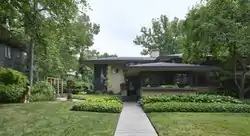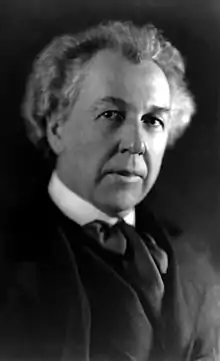Walter V. Davidson House
The Walter V. Davidson House, located at 57 Tillinghast Place in Buffalo, New York, was designed by Frank Lloyd Wright and built in 1908. It is an example of Wright's Prairie School architectural style. The house is a contributing property to the Parkside East Historic District,[2] a neighborhood laid out by renowned American landscape architect Frederick Law Olmsted in 1876,[3] and also a City of Buffalo landmark.[4]
| Walter V. Davidson House | |
|---|---|
 | |
 | |
Interactive map showing the Walter V. Davidson’s house location | |
| General information | |
| Type | Wood & Stucco[1] |
| Architectural style | Prairie School |
| Location | 57 Tillinghast Place, Buffalo, NY |
| Coordinates | 42.942028°N 78.853886°W |
| Construction started | 1908 |
| Governing body | Private |
| Design and construction | |
| Architect(s) | Frank Lloyd Wright |
The Client
Wright's patron, Walter V. Davidson, had joined the Larkin Company in Buffalo as the advertising manager[5] in 1906.[1] Davidson was introduced to Wright by fellow Larkin executive Darwin D. Martin.[5] Wright had arrived in Buffalo in 1903 to build the existing house for Martin,[5] and Martin was instrumental in selecting Wright as the architect for the Larkin Administration Building,[5] in downtown Buffalo, Wright's first major commercial project. Consequently, Wright was commissioned to build a house by Davidson, and in turn another Larkin employee William R. Heath. Davidson left both the house and the Larkin Company in 1913 to establish the Davidson Shoe Company.[1]
Design
In a house built on a relatively modest budget, Wright emphasized space and light rather than ornament.[1] This helped make the Davidson House notable in several respects, primarily as a "Tall Living Room" house.[6][7] The living room is two stories high[1][8] featuring a 2-story bay window on the east wall[1] and 1+1⁄2-story-high[6] clerestory windows on the north and south walls.[1] Due to the large area of glass, and the restricted budget, the house is also notable in that the windows do not incorporate the use of art glass, as in many other Wright houses of the period: instead the windows consist of leaded diamond-shaped panes. These panes are oriented horizontally, rather than vertically, uncommon to the style of the day but in keeping with Wright's emphasis on the horizontal. Each pane is offset a number of degrees, rather than laid flat on an even plane, increasing privacy due to light reflecting off the glass at different angles.
The basic floor plan is cruciform.[8] On the ground floor is the dining room, and at the opposite end a porch, with the "Tall Living Room" and the second story centered in the middle. The floor plan is almost identical to the Isabel Roberts House, built that same year in River Forest, Illinois, but mirror-imaged and rotated ninety degrees from the street.[9] This resulted in the living room being oriented to the side of the house rather than the street front, which initially afforded a nice view of the woods in 1908. This view was quickly lost, however, when the house next door was built.[6] Like the William R. Heath House the Davidson House has a half-level basement containing the utilities,[8] a laundry, pantry, and maid's quarters. Nearby are the kitchen and side entry on the ground floor.[8] There are three bedrooms and bathroom on the second floor.[8]
The exterior and interior of the house incorporate typical Prairie School elements found in most of Wright's designs of the era: broad overhanging cantilevered eaves, low hip roofs, bands of casement windows, Roman brick in the fireplace and hearth, vertical wooden slats creating a screen to hide the stairway, built-in exterior planters, and an overall emphasis on horizontal lines throughout.[7]
Renovation
In the 1930s the residence was remodeled,[1] updating the kitchen and creating a master suite built over the garage.[1] One of the original bedrooms was reduced in size and a closet eliminated to make way for a hallway leading to the new suite, which consisted of a dressing chamber, bathroom, and sleeping chamber. The addition incorporated the same casement windows of diamond-shaped leaded glass prevalent in the rest of the house.
Photo gallery
 Walter V. Davidson House
Walter V. Davidson House Dining Room with Built-In Side Board
Dining Room with Built-In Side Board View of Sun Porch looking towards living room
View of Sun Porch looking towards living room Interior view of front entrance
Interior view of front entrance Living room with two-story bay window
Living room with two-story bay window
See also
References
- Reyner Banham & Francis R. Kowsky, Buffalo Architecture, p.206-207, Buffalo Architectural Guidebook Corporation; 1981
- "Parkside East Historic District". New York State Historic Preservation Office. August 1986. p. 6. Retrieved 2009-07-22.
- Darwin Martin House Complex: Reference Sheet
- "You Can Blame Us: Frank Lloyd Wright Houses Now Official Buffalo Landmarks". The Campaign for Greater Buffalo History, Architecture & Culture. Retrieved 2020-04-14.
- Edgar Tafel, Years with Frank Lloyd Wright: Apprentice to Genius, p.83, Courier Dover Publications; 1985
- Thomas Heinz, The Vision of Frank Lloyd Wright, p.135-141, Chartwell Books; 2000
- Davidson House at Wright Now In Buffalo .com
- William Allin Storrer, The Architecture of Frank Lloyd Wright, p.147, The University of Chicago Press; 2002
- Brendan Gill, Many Masks, p.195, Da Capo Press; 1998
- Charles E. Aguar and Berdeana Aguar, Wrightscapes: Frank Lloyd Wright's Landscape Designs, McGraw-Hill; 2002 ISBN 0-07-137768-9
- Diane Maddex, Wright-Sized Houses: Frank Lloyd Wright's Solutions For Making Small Houses Feel Big, Harry N. Abrams Inc; 2003 ISBN 0-8109-4626-2
- Grant Carpenter Manson, Frank Lloyd Wright to 1910: The First Golden Age, Van Nostrand Reinhold Co Inc; 1958 ISBN 0-442-26130-6
- William Allin Storrer, The Frank Lloyd Wright Companion, University of Chicago Press; 2006 ISBN 0-226-77621-2, (S.149)
See also
Other buildings by Frank Lloyd Wright in the Buffalo area:
- Darwin D. Martin House Complex
- Graycliff
- William R. Heath House
- Blue Sky Mausoleum
- Rowing Boathouse
- Filling Station
And;
- More Photos The Walter V. Davidson House
- Information about Buffalo's architecture: Wright Now in Buffalo
- Podcast of remarks about Buffalo architecture by Dr. Neil Levine, author of The Architecture of Frank Lloyd Wright, and Emmet Blakeney Gleason, Professor of History of Art and Architecture at Harvard University
